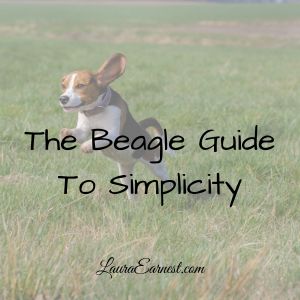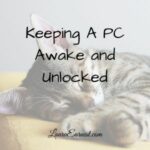While I was writing the article about cat deliberate living, I caught my dog looking at me sadly. A beagle, she has mastered the whole “puppy dog sorrowful look.” That’s actually why I have a dog right now, but that’s another story for another time. Our dog was an older beagle, adopted as an adult from a rescue, we think about 9 or 10. She is sweet, loving, and generally happy.
My dog looked at me for inclusion. She wanted to be on the interwebs too! But no one would ever accuse my dog of being productive. She was a beagle. For those who don’t know beagles, they aren’t the brightest dogs in the world. In fact, Stanley Coren lists them at the bottom of the list for intelligence.
Still, my dog had things that she can teach me. She had few needs, few desires. Her life was peaceful and simple.
So here is the Beagle’s Guide to Simplicity.
What Are My Needs?
My dog had very simple needs: food, water, a comfy place to sleep, walks, and pets. Everything else is extraneous. She didn’t seek out toys, she would sleep anywhere, she would eat anything put in front of her (and some things not put in front of her). She met her needs in the most straightforward way possible, and was fine with that.
Human application: do we really need the gadget with all the extra features? Do we even need the gadget? Example: my fancy coffee pot broke just a little over a year after purchase. Since coffee is a need for me, I purchased a very simple model and put it on an appliance timer.
Simple Communication
My beagle was abused before we got her. We weren’t been able to piece together her whole story, but we knew that she would not bark unless there was a person in the house (and usually not until they are well into the house — see the intelligence comment above). This means that she would not bark to communicate her needs.
However, she had other ways of communicating. If she wanted companionship, she would lay down at my feet. If she wanted to be petted, she would nudge my hand. If she needed to go outside, she would jump up and put her forepaws on me. There was no guessing. There was no subtlety. She was very direct.
Human application: can you cut the fluff out of your communication? Can you answer every email in 3 sentences or less? Can you be direct and not beat around the bush? Example: if I have a single message to communicate, such as my time sheet is ready to approve, I put that in the subject line and put “– end of message –” at the end of the subject line. I leave the body blank, and the recipient knows he doesn’t have to read anything more.
Taking Things As They Come
My dog was never stressed, except at the vet. She didn’t care if we go camping on a weekend, or stay home, as long as she was with her “pack”. She went with the flow and never had trouble sleeping.
Human application: don’t sweat the small stuff, and it’s all small stuff. If you ask yourself if this is going to matter next week or next year, and the answer is “no”, let it go.
Making Do
My dog wasn’t fussy. Particularly about where she slept. She could sleep on the floor, in a chair, on the sofa, on a pillow, in her crate, on my bed or in her dog bed. When we went camping, she just found a soft spot and went to sleep. When we’re traveling, she curled up on the seat. She made do with whatever is available wherever she is. She accepted what she has and used it.
Human application: we all have expectations. But what would happen if instead of wanting things different we just accepted what they are? Example: my husband works three hours away and is gone during the week. I could complain and be grumpy about it, but instead I take the extra time to knock things off my project list.
Unbridled Enthusiasm
One of the most amazing things I have learned about dogs is that they are enthusiastic. My dog didn’t hold herself back when she was excited. If you’ve ever seen Snoopy dancing for dinner in the Peanuts cartoons, let me tell you that is real. Beagles dance for dinner. Mine also danced as soon as she saw me putting on my shoes and coat. When she did something it was with full focus and energy. There was no partial attention for her.
Human application: when we focus on the thing we are doing, we can fully immerse ourselves in it and enjoy it. We don’t have to be distracted by other thoughts and worries. Example: when I am eating, if I am thinking of other things, I will overeat because I am not tasting my food. By focusing on a meal, I taste my food and register when I feel full.
Canines are the master of simplicity. We can learn a lot from them.







